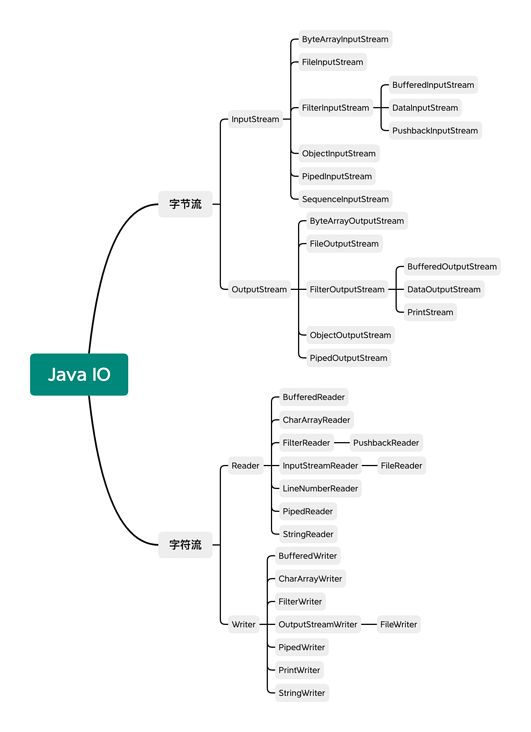应用场景
装饰器模式主要解决继承关系过于复杂的问题,通过组合来替代继承。它主要的作用是给原始类添加增强功能。
装饰器模式有一个特点,那就是可以对原始类嵌套使用多个装饰器。为了满足这个应用场景,在设计的时候,装饰器类需要跟原始类继承相同的抽象类或者接口。
聊聊Java IO类
Java IO 类库非常庞大和复杂,有几十个类,负责 IO 数据的读取和写入。我们可以把IO类分为四类。
| 字节流 | 字符流 | |
|---|---|---|
| 输入流 | InputStream | Reader |
| 输出流 | OutputStream | Writer |
针对不同的读取和写入场景,Java IO 又在这四个父类基础之上,扩展出了很多子类。
相信大多数开发者在初次接触Java IO类时面对庞大的Java IO类家族产生困惑:为什么会有如此多的类?他们使用上有啥区别?
这里以读取 config.properties 文件为例,InputStream 是一个抽象类,FileInputStream 是专门用来读取文件流的子类。BufferedInputStream 是一个支持带缓存功能的数据读取类,可以提高数据读取的效率。
InputStream in = new FileInputStream("config.properties");
InputStream bin = new BufferedInputStream(in);
byte[] data = new byte[128];
while (bin.read(data) != -1) {
//...
}Java IO 为什么不设计一个继承 FileInputStream 并且支持缓存的BufferedFileInputStream 类呢?这样我们就可以直接创建new BufferedFileInputStream() 简单许多。
继承的问题
事实上如果只是扩展这一个类,那还可以接受,但是InputStream具有很多子类,如果我们继续按照继承的方式来实现的话,就需要再继续派生出 DataFileInputStream、DataPipedInputStream 等类。如果我们还需要既支持缓存、又支持按照基本类型读取数据的类,那就要再继续派生出 BufferedDataFileInputStream、BufferedDataPipedInputStream 等 n 多类。这还只是附加了两个增强功能,如果我们需要附加更多的增强功能,那就会导致组合爆炸,类继承结构变得无比复杂,代码既不好扩展,也不好维护。
所以Java的设计者没有使用继承的方式来进行扩展,而是使用组合,这里也体现了组合优于继承的设计原则。下面是简化的JDK源码
public abstract class InputStream {
// ...
}
public class BufferedInputStream extends InputStream {
protected volatile InputStream in;
public BufferedInputStream(InputStream in) {
this.in = in;
}
// 实现基于缓存的读取...
}
public class DataInputStream extends InputStream {
protected volatile InputStream in;
public BufferedInputStream(InputStream in) {
this.in = in;
}
// 实现读取基本数据类型...
}如果去查看 JDK 的源码,你会发现,BufferedInputStream、DataInputStream 并非继承自 InputStream,而是另外一个叫 FilterInputStream 的类。
这是因为InputStream是一个抽象类,其中很多方法已经有了默认实现。我们想复用这些实现,但是我们是通过在构造函数注入InputStream,然后赋值给成员变量InputStream in,将所有功能委托给成员变量in来实现的,因此抽象类InputStream的方法即使被继承,调用的对象也是当前类实例,而不是委托给in,所以需要有一个装饰器类FilterInputStream。
public class FilterInputStream extends InputStream {
protected volatile InputStream in;
protected FilterInputStream(InputStream in) {
this.in = in;
}
public int read() throws IOException {
return in.read();
}
public int read(byte b[]) throws IOException {
return read(b, 0, b.length);
}
public int read(byte b[], int off, int len) throws IOException {
return in.read(b, off, len);
}
public long skip(long n) throws IOException {
return in.skip(n);
}
public int available() throws IOException {
return in.available();
}
public void close() throws IOException {
in.close();
}
public synchronized void mark(int readlimit) {
in.mark(readlimit);
}
public synchronized void reset() throws IOException {
in.reset();
}
public boolean markSupported() {
return in.markSupported();
}
}装饰器模式是简单的“用组合替代继承”吗?
当然不是。从 Java IO 的设计来看,装饰器模式有两个比较特殊的地方:
- 装饰器类和原始类继承同样的父类,这样我们可以对原始类“嵌套”多个装饰器类。
InputStream in = new FileInputStream("content.txt");
InputStream bin = new BufferedInputStream(in);
DataInputStream din = new DataInputStream(bin);
int data = din.readInt();- 装饰器类是对功能的增强,这也是装饰器模式应用场景的一个重要特点。
跟代理模式的区别
代理模式中,代理类附加的是跟原始类无关的功能,而在装饰器模式中,装饰器类附加的是跟原始类相关的增强功能。
类图
代码实现
Shape
public abstract class Shape {
public abstract void draw();
public abstract void doOther();
}Circle
public class Circle extends Shape {
@Override
public void draw() {
System.out.println("You are drawing circle...");
}
@Override
public void doOther() {
System.out.println("You are doing other...");
}
}Square
public class Square extends Shape {
@Override
public void draw() {
System.out.println("You are drawing square...");
}
@Override
public void doOther() {
System.out.println("You are doing other...");
}
}ShapeDecorator
public class ShapeDecorator extends Shape {
protected Shape shape;
public ShapeDecorator(Shape shape) {
this.shape = shape;
}
@Override
public void draw() {
shape.draw();
}
@Override
public void doOther() {
shape.doOther();
}
}RedShapeDecorator
public class RedShapeDecorator extends ShapeDecorator {
public RedShapeDecorator(Shape shape) {
super(shape);
}
@Override
public void draw() {
shape.draw();
System.out.println("The shape color is red");
}
}Main
public class Main {
public static void main(String[] args) {
Shape shape;
RedShapeDecorator decorator;
shape = new Circle();
decorator = new RedShapeDecorator(shape);
decorator.draw();
decorator.doOther();
shape = new Square();
decorator = new RedShapeDecorator(shape);
decorator.draw();
decorator.doOther();
}
}
